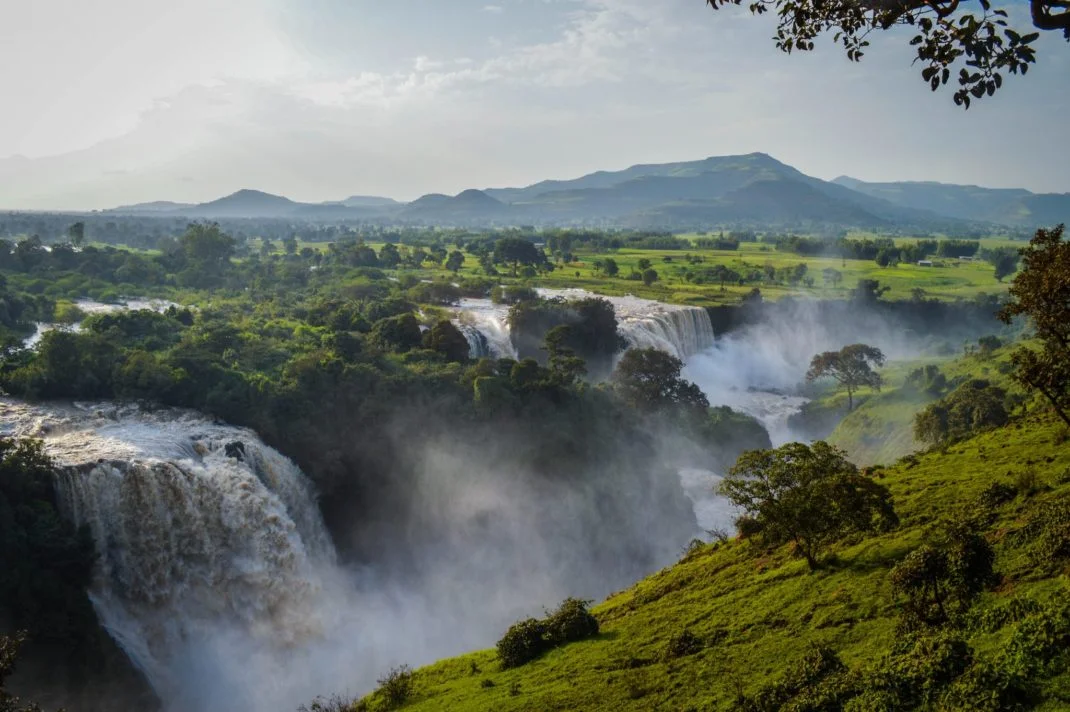Addis Ababa and Lake Tana – Ethiopia
Ethiopia’s Northern Historic circuit will erase all preconceptions you have regarding this nation. You will witness rock-hewn churches carved by angels, towering obelisks built by the ancient Aksumite Empire, and impossibly green mountains inhabited by armies of gelada baboons. You will cross terraced farmlands, frigid mountains, scorching deserts and some of Ethiopia’s most raw, beautiful scenery. Whatever your thoughts about Ethiopia are now, you will be amazed to see the magic this incredible country conceals deep in the North. This is a four part series of my journey through Ethiopia’s north. I chose to only take local transport so I could travel as the locals do, and take in as much of the “off the beaten track” country side as possible. Tag along with me and follow this epic series.
Holy Trinity Cathedral just north of Itegue Taitu HotelFirst Stop: Addis Ababa
My plane landed in the Ethiopian capital, Addis Ababa, in the early hours of the morning. The guide books warn you to bring US cash. I, however, did not listen to this. I thought that I would just arrive and use the ATM in the airport. This did not happen. The ATM was broken, and the Ethiopian officials would only take US cash for the visa. After some serious negotiating the Border, officials gave me a temporary visa allowing me to enter Addis Ababa to go and get money. My troubles did not end here. The taxi stand outside is well aware that travelers often run into this situation. They use this knowledge to force tourists to pay three times the normal price, just to go to the ATM. Let’s just say that I needlessly lost a lot of money that day.
Injera baskets for sale on the streets of AddisVisa in hand, I was hit the streets of Addis. First stop was my hotel the Itegue Taitu. This hotel was built by Empress Taitu in 1907. The hotel in itself is a sight to see in the city. It’s composed of quaint, colonial-style dining rooms and large wooden beams. Rooms are cheap, so I recommend staying at this central location.
Spice shops in Addis Ababa’s MerkatoStuffed full of Injera (Ethiopian sour flat bread) and some of the most amazing coffee I have ever drank, I headed out towards Ethiopia’s largest market; dubiously named Merkato. The Merkato is an exhilarating experience. It’s crowded with Ethiopians from every corner of the country, all yelling and haggling for lumps of butter, spices, leather, and a variety of other such products. The pungent smell of spices will burn your nose and soon after be replaced by the reek of sour butter and open sewers. Donkey carts push through the crowds and locals often stop you to chat about why you decided to come to Ethiopia. The Merkato is intense, so come prepared. A word of caution: watch your belongings; as theft is quite a common occurrence here. Dig deeper into the Merkato, and you will even find a few antique stores selling both tribal and Christian artifacts from many regions.
Busy streets in the heart of the MerkatoAddis is a great city to just walk around; and get lost in. After the Merkato, I did just that. Finding myself very lost in a rural part of town, I asked a friendly man named Solomon, an Addis local who was the same age as me, how to get to the National Museum. He decided to take me there himself. Solomon wanted to make one stop before the museum. This stop was at his favourite Tej Bet. Tej is a local wine made from honey and served in what looks like a flask from a chemistry set. What was meant to be a quick stop turned into an afternoon of crushing back Tej with the locals. This sweet tasting elixir conceals its potent alcohol content, be warned.

Waking up early the next day, I walked from Tegu to the National Museum. Packed full of Lucy artifacts, dating back to the beginning of time, this fascinating museum will take you step by step through the history of Ethiopia, and our human evolution. From the museum, I trekked over to the Holy Trinity Cathedral. While wandering in the courtyard, a resident priest invited me in. He explained the murals on the walls to me (my favourite is the black Jesus!) and let me play with the massive drums they use during ceremony. This was an incredibly informative introduction to the Ethiopian Orthodox religion.
Addis Ababa is not just known for its markets and churches. It also has a vibrant nightlife. That night, Solomon took me out to experience Addis at night! The night included Tej, lots and lots of Tej. I was introduced to the different variations of Tej. Strong, Sweet, Bitter, Fresh, Tej has many names, but the one thing you will remember about Tej is how it brings everyone together. When Ethiopians drink Tej, the drumming and songs begin. The rhythmic beat of Ethiopian style music is paired with the fast paced shoulder dance. As a foreigner drinking Tej with the locals, expect that you too will also have to do this shoulder dance. You will be made fun of, but you will also remember an evening like this for the rest of your life.

Onward to Lake Tana
In the early hours of the morning you can catch buses of decent quality to Lake Tana from Addis’s Auto Bus Terra. Make sure you arrive early as the tickets go fast. The drive was supposed to take around 12 hours. After breaking down twice on the side of the Choke Mountains I made it in 15 hours. The drive to Lake Tana is visually stunning. Massive green mountains covered in teff terraces, small villages dotted with grass huts. The 15 hours were pleasant and well worth the time.

Bahir Dar is the name of the town on Lake Tana. It is a pleasant, calm community with swaying palm trees and fresh air. There are a few decent hotels in town that are great for helping you with getting to the island churches and Blue Nile Falls. I chose the Din Anbessa Hotel.
Ceremony for Meskel. Drums beat and singing filled the airThe next day, my hotel arranged for me to join a boat that was visiting some of Lake Tana’s island monasteries. The first island monastery was the Narga Selassie. As luck would have it, I was able to witness an Orthodox ceremony. Drums beat continuously, the deep bass vibrations resonating within the ground. The men chanted hypnotically in their white garments. In the background, you could hear bells clanging and women chanting in soft tones. The air was thick with frankincense, filling my nose with its sweet smell. I spent hours just observing this spectacle, joining in here and there with the proceedings. I did not understand everything that was happening, but it was pure magic. I could feel the power here.
Murals inside the Island MonasteryBuzzing from the energy, I visited a few lesser known monasteries that were filled from floor to ceiling with murals depicting heroic saints and angles telling stories of the past. The priests in these temples are happy to tell you about the murals. They also went into detail about how the Ark of the Covenant was located on a secret island near here.

That evening, the ceremony of Meskel (finding of the true cross) was taking place. Throughout Bahir Dar, crosses were carried around by chanting groups to locations where a giant bonfires were being prepared. After sunset, the bonfires were lit and religious processions began. The bonfire at my hotel happened to be one of the biggest in town that night. Roaring flames reached about twenty feet high and burned well into the night.
Every Ethiopian I met told me I had to see the Blue Nile Falls. On my last day in Bahir Dar, I did just that. From town, it’s a short jeep ride to the trail head. The trail itself is not long, but every corner you turn you are blasted with incredible waterfall views. Many local children follow you trying to sell trinkets made from cow leather and reeds they put together. These same children can become fantastic guides who, more often than not, speak enough English to give you a proper understanding of the area. I spent the day wandering around the falls. The views are staggering in the different light of the setting sun.
Lake Tana Orthodox Ceremony
The night ceremony for Meskel, finding of the true cross

Useful Information
Location: Addis Ababa, Lake Tana, Bahir Dar – Northern Ethiopia
Costs: Bus Ticket, Addis – Bahir Dar 15 US$, Boat trip on Lake Tana – 40 US$ Itegue Taitu Hotel 15 – 40 US$ depending on room. Din Anbessa Hotel – 18 US$
Tips: Island monasteries sometimes charge individual entrance for each church. This can add up fast. Look around town for others in Bahir Dar to split the boat trip cost with. Watch your pockets in Addis Ababa Merkato, thieves are about.
Recommended Guide Book: Lonely Planet Ethiopia
Transport: Addis to Bahir Dar there are basic buses and more “luxurious” models. The luxury coach is about double the price. You can always take minibus but they take a lot of time, and are very uncomfortable. Lake Tana has boat taxis to some monasteries, but are infrequent. Best to rent a boat for the day.






The way you jotted down your blog is beyond awesome.
Thanks for sharing..